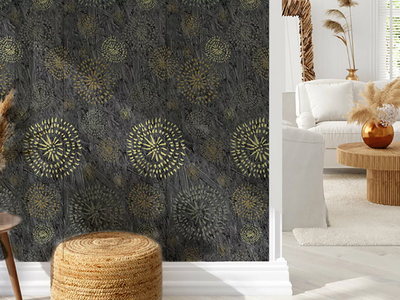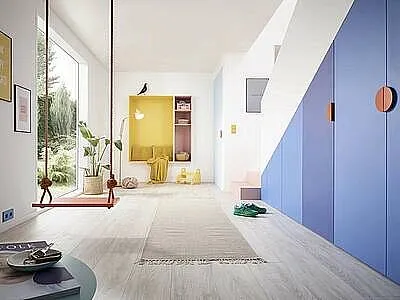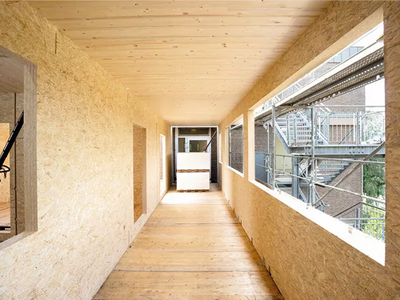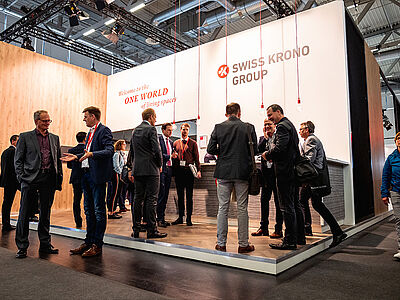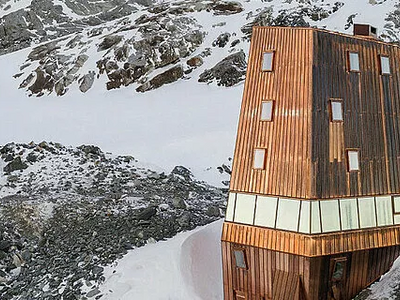Urban Construction
Green building: urban construction in transformation – the changing needs and expectations of urban societies and how timber construction can play a major role in meeting them.
The overall housing situation in Europe’s cities and metropolitan areas has changed dramatically. Twenty years ago, there was an exodus from urban areas to the countryside, but more recently the flood has slowed to a trickle. As a result, the demand for living space in city centres, and especially for affordable housing, is steadily rising, and needs are also changing. Alongside cost-effectiveness and energy efficiency, now aspects such as sustainability and healthy living are moving into the spotlight.
Not much space is available for new housing, which makes it essential to take advantage of any gaps, empty lots, and still-undeveloped areas while also extending existing buildings upwards and taking other steps to utilise urban land more efficiently. It is up to communities to take a responsible approach and make sensible long-term plans instead of simply going into an uncontrolled construction frenzy and inadvertently wasting valuable living space. New inner-city housing ought to be attractive, sustainable and affordable, harmoniously blend into its surroundings, and ensure a balance between residential areas and parks etc. If all of these things can be achieved, it improves the quality of life. Modern timber construction methods can make a crucial contribution to this, while benefiting both people and the environment. This vision of sustainable building with wood is spreading, both in society in general and among architects and engineers in the construction industry. „Originally, sustainability was equated with energy efficiency. But some time ago, the definition was extended to include all efforts to avoid squandering raw materials. These days, a construction method doesn’t deserve the label of “sustainable” or “green” unless it holistically addresses a raw material’s entire lifecycle and uses it in sensible, resource-conserving ways.
“Green building” is the keyword. Embracing all of the phases of a building’s lifecycle, it focuses on using raw materials sustainably – in everything from the planning and construction of houses across their use and maintenance all the way to their eventual demolition. Priority is consistently attached to using energy and natural resources frugally while minimising environmental burdens.
The Revolution in Building
The trend towards “green building” is driving a general change in consciousness and attitudes. Even more importantly, it is broadly revolutionising the construction sector. There is talk of a renaissance of timber construction, the diverse benefits of which are unmatched by any other approach. Across the board – in respect of climate change, resource conservation, cost-effectiveness, time, and social and sociocultural factors – wood can make a crucial contribution to and support, strengthen and ultimately revolutionise this transformation. Modern timber construction has a long list of significant advantages in its favour.
From a global perspective, it makes good sense to lastingly store as much carbon dioxide as possible in buildings in the form of wood and wood-based construction materials, which have the added advantage of greatly reducing the need for primary energy for heating etc. In addition, it takes far less fossil fuel to convert wood into construction materials than to produce steel, concrete, plastics, bricks or aluminium.
Wood Has Outstanding Properties
Wood is a renewable raw material. Every five seconds, enough new wood grows in Germany’s forests alone to build an entire single-family home. Natural wood owes its structure to a combination of insulating cavities and moisture-regulating cell walls, making it ideal for virtually all uses. Despite being relatively lightweight, wood is extremely strong. Moreover, as it is naturally a very poor heat conductor, it is ideal for building alternative, highly energy-efficient structures such as passive and zero-energy houses.
Wood also plays an important role in offsetting climate change by very naturally using photosynthesis to bind carbon.
No other raw material matches wood’s versatility: even the tiniest leftover bits, as well as all production scrap, can be reused. This includes incinerating them to release the energy they contain, but preferably not until the end of a long, sensible product lifecycle. Wood thus meets today’s wish for sustainability and extensive recycling and richly deserves its reputation as an environmentally valuable, forward-looking, green building material.
SWISS KRONO has long advocated cascading, or sequential, reuse of wood and therefore requires all of its facilities to comply with strict sustainability criteria. This mainly involves making sure that wood doesn’t serve as a source of energy until it reaches the end of its lifecycle after being used for as many other purposes as possible. SWISS KRONO in Germany mainly uses wood from sustainably managed domestic forests to make its products, which is why all SWISS KRONO OSB bears the PEFCTM mark. In addition, the manufacture of SWISS KRONO engineered wood is almost completely carbon-neutral. Attention is paid to using renewable energy sources, not wasting any raw materials, and minimising the distances that finished products are transported. Besides environmental criteria, economic, social and sociocultural aspects receive a great deal of attention.
Modern Timber Construction
When building new houses, filling in gaps in the urban landscape or modernising existing buildings, wood and wood-based materials are suitable for a virtually limitless spectrum of uses. Single-family detached homes, multi-storey blocks of flats, vertical extensions, upgrading: almost anything can be done with wood, and quickly too. A major advantage of modern timber construction is that it permits very precise prefabrication of elements and assembly of them into any conceivable layout.
Wood is wonderfully suited for use in combination with other kinds of building materials. The relatively lightweight elements made with it are also ideal for adding storeys, among many other things. In contrast to masonry and concrete construction, timber is a dry approach. And by prefabricating large elements beforehand, an extra storey or entire house can be assembled and sealed in a single day. The building is thus immediately protected from the wind and weather and follow-on trades can get straight to work on the interior to get it ready for occupancy. State-of-the-art woodworking methods, in tandem with extensive prefabrication, result in top-quality, affordable single- or even multi-storey constructions.
Energy-Efficient Timber House
Nowadays, low-energy and even zero-energy houses have progressed from being rarities and actually become quite common. Wood and wood-based materials are naturally thermally insulating. The SWISS KRONO MAGNUMBOARD® OSB system is also excellent in this respect, as it has a large thermal mass and therefore very low thermal conductivity.
Due to the limited availability of space in city centres, prefabricated elements are also the preferred approach there. They can be brought in and immediately hoisted into place, which reduces costs while making them calculable.
Fear of Fire
Humans have always been afraid of fire. This innate fear causes many owner-builders to shy away from timber construction. The misconception is widespread that a wooden house will burn faster than one erected using conventional materials. But the opposite is true: wood actually provides protection from fire! When exposed to flame, the surface of wood chars to form a layer that reduces the likelihood that it will catch fire. Unlike steel, wood reacts predictably to fire.
In terms of fire protection, today wood is an excellent choice. Although wood is certainly a flammable material, a number of precautionary measures are required by building codes and ordinances. As a result, today’s timber houses meet all fire protection requirements just as well as a conventional concrete or masonry building, and this statement also applies to multi-storey houses as well.
Because of its homogeneous structure, SWISS KRONO MAGNUMBOARD® OSB system burns at a defined, predictable rate, which makes it possible to assess the durability and fire resistance of timber structures as defined by DIN EN 1995-1-2. Taken together, this also qualifies the SWISS KRONO MAGNUMBOARD® OSB system for taller and subterranean structures with large rooms (building classes 4 and 5 in Germany).
There are now many reference buildings that illustrate what is architecturally possible and the vast range of things that can be accomplished with wood.
More Rentable Living Space with Sustainable Building
The goal is to create more affordable living space and high-quality, sustainable habitats that let people of all incomes live in an intact urban environment while respecting the environment.
The solution: well-designed quarters comprising multi-storey residential buildings made of timber, along with sufficient greened areas, access to shops and good connections to public transport. This can ensure a long-term balance of nature and urbanity while making a crucial contribution to improving people’s lives and protecting the environment.
Today, wood is a modern and forward-looking high-tech building material that excellently combines traditional values with compliance with current requirements for climate protection and sustainability. Here is an overview of its advantages:
- A renewable raw material
- Environmentally beneficial
- Carbon-neutral (both the raw material itself and other materials made from it)
- Much lighter than steel and concrete
- Fast construction with extensive prefabrication
- Energy savings and storage of CO2
- Dry construction
- A wide variety of wood types and timber construction methods is available for doing almost anything with wood: from timber-frame to modular construction and from skeletons to exterior walls.
- Excellent physical properties: sturdy, compression-proof, lightweight, durable, elastic and airtight
- A predictable reaction to fire; safer than steel
- Moisture regulation for a pleasant indoor climate
- Conducive to good health
- Suitable for people with allergies
- Acoustically insulating
- Protection from heat and cold
- Resource conservation

